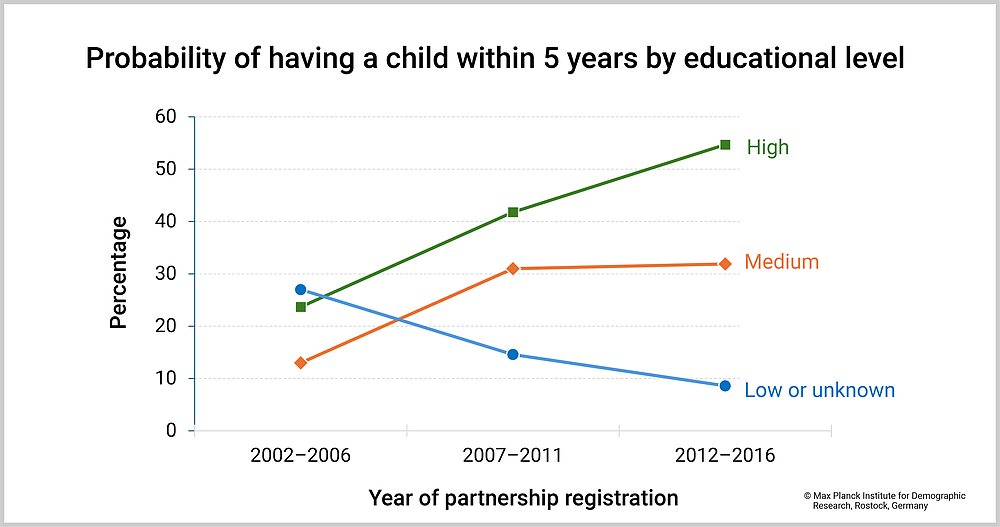December 05, 2024 | News
Education Level Predicts Childbearing Trends in Same-sex Partnerships
Study reveals increasing fertility among female couples in Finland
A new study by the University of Helsinki and the Max Planck Institute for Demographic Research (MPIDR) has examined the fertility trends of same-sex female couples in Finland. The data shows a significant increase in the likelihood of these couples having a child within five years of registering their partnership, rising from 20% to 45% for partnerships registered between 2002 and 2016. This trend was particularly pronounced among couples with a higher level of education, while the probability decreased among couples with a lower level of education. Despite supportive Finnish legislation, large disparities in access to parenthood persist, highlighting the need to eliminate remaining barriers to childbearing, particularly in the context of falling fertility rates.

Finland: Chances of same-sex female couples having a child within five years of registering increased from 20% to 45% for partnerships registered between 2002 and 2016. © istockphoto.com / bernardbodo
While extensive research has been focused on the fertility of married heterosexual couples, the experience of same-sex couples has received far less attention. For example, how many children do women have in same-sex partnerships? A new study from the University of Helsinki and the Max Planck Institute for Demographic Research (MPIDR) explores how the likelihood of women in same-sex partnerships in Finland having a child has evolved in recent years, and how education influences this likelihood. Researchers Maria Ponkilainen, Elina Einiö, Marjut Pietiläinen and Mikko Myrskylä analyzed data from the Finnish Population Register, provided by Statistics Finland. The analysis included data on same-sex female couples who entered registered partnerships between 2002 and 2016.
The study found that the likelihood of female couples having a child within five years of registering their partnership surged from 20 per cent for those who registered between 2002 and 2006, to 45 per cent for those who registered between 2012 and 2016. “This increase was particularly significantly for couples with a high level of education and, to a lesser extent, for couples with a medium level of education. At the same time, it decreased for couples with a low level of education,” explains Maria Ponkilainen.
The educational gap in terms of childbearing has shifted dramatically during the observation period. Ponkilainen continues, "Among couples who registered their partnership between 2002 and 2006, those with lower education levels were most likely to have a child. In contrast among couples who registered later, those with a high level of education were most likely to become parents," says Ponkilainen. Educational differences in fertility were only slightly explained by couples' income levels.

Female couples with higher levels of education are more likely to have a child in the first five years of their registered partnership.
The researchers can only speculate about the factors contributing to these trends. "One explanation could be the legalization in 2007 of fertility treatments to tin same-sex relationships. This means that female couples have improved opportunities to achieve pregnancy without involving a third person in the parental network. But access to these treatments requires significant socioeconomic resources," says Ponkilainen.
The study only looked at female couples who had registered their partnership, because same-sex marriages have only been legal in Finland since 2017. Same-sex couples who have not entered into a legal union are not recorded in Finnish administrative registers. “As a result, we could not investigate whether there are any selection effects for registered partnerships, or whether there is a link between partnership registration and family planning. It could be that couples who want to have children also have an incentive to register their partnership,” says the researcher.
Despite these limitations, the results provide an initial deeper insight into childbearing patterns among same-sex couples. While Finnish legislation has recognized same-sex partnerships and parenthood, thereby improving access to family life with children, not all same-sex couples have been able to benefit equally from these new opportunities. The increasing disparity between the likelihood of having children between couples with different levels of education may signal underlying barriers to family formation. “In light of overall declining fertility rates, it is essential to reduce these barriers,' says Maria Ponkilainen. For context, the probability of having a child in the first five years for heterosexual couples married between 2002 and 2016 was about 70 per cent, putting them well ahead of women in same-sex partnerships. The future will show whether fertility among heterosexual couples will continue to fall, and fertility among female couples continue to rise.
Original Publication
Maria Ponkilainen, Elina Einiö, Marjut Pietiläinen, Mikko Myrskylä: Educational Differences in Fertility Among Female Same-Sex Couples in Demography (2024), DOI: 10.1215/00703370-11687583
Keywords
Same-sex couples, Registered partnership, Family formation, Childbearing, Educational level